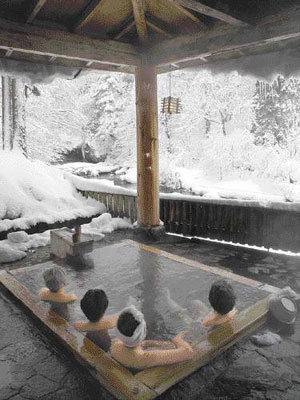Amazed by Snowy Scenery, Relaxed by Hot Steam
Amazed by Snowy Scenery, Relaxed by Hot Steam
Posted February. 15, 2008 07:14,

In Honshu, Japan, there is a region where it snows astoundingly though not as much as the birthplace of the novel Snowy Country, Niigata Prefecture. Its the northern Tohoku region that comprises the northernmost part of Honshu. The region refers to three prefectures: Aomori to the north and its southeastern and southwestern neighbors, Akita and Iwate. While the latitude of Niigata is similar to that of Seoul, northern Tohoku is placed further away to the north that its latitude is similar to that of Cheongjin (38-42 degrees) in North Korea. Among the three prefectures, Akita is the best place to enjoy a hot spring bath surrounded by mountains covered with white snow in mid-winter. This time, the trip was made to the Akinomiya hot spring in Akita Prefecture which is a good place to watch the snowy scene having a hot spring bath outdoors.
It took two hours and a quarter from Incheon International Airport to Akita Airport. From the window of the plane, everything was white around the airport. The Akinomiya hot spring zone is located deep in a mountain valley in the southern part of Akita. Therefore it takes two more hours from the airport by car or train. On the way to Akinomiya, you can stop by Yokote City, which used to be the downtown of Akita Prefecture in the past with a well-preserved old castle. Yokota is also famous for the Kamakura Festival held on Feb. 15 and 16 every year.
Kamakura refers to an icehouse similar to the igloos of Eskimos. Kamakuras were built and used by hunters as temporary lodges so as to hide from the chill and the snow in deep mountains in old days. After sunset, I headed to the festival being held in the field of Minami Elementary School. Instead of a kamakura, I came across the amazing scene of hundreds of 30-centimeter-high icehouses with candles lit inside them, brightening the dark in the snowy field. Inside the icehouses next to the candles, were nekaifudas, or labels of wishes.
The real kamakura stood at the bukeyashiki (samurai house), next to the school building. In the two-meter-high interior, there was a nameplate that read Mizukami (the God of Water)" and a grownup and a child were sitting at the brazier in front of the plate. This kamakura was built to serve the God of Water. Considering that Akita Prefecture is the breadbasket of Japan and is famous for sake (Japanese rice wine), it is easily understandable why the God of Water is served so dearly here.
The next morning, it was clamorous at the plaza in front of Yokote City Hall. Despite the freezing weather, hundreds of half drunken men dressed in festival garments were walking in a parade, shouting out loud with a fancily decorated doll poll on their shoulders. They were heading to a shrine in Asahioka Mountain. It was a sort of winter festival in the prefecture for towns to compete against each other to carry doll polls to the shrine.
Akita Prefecture is renowned as a region of hot springs. Among them, Nyuto with Tsurunoyu and Akinomiya with Dakanoyuka are the most famous. They are where the hot springs of Akita with twelve dazzling views, also called Junihitoyu, are placed. The Akinomiya hot spring zone on the mountain foot of Kurikoma has the longest history among others and is gaining the biggest popularity in recent days. Out of about ten ryokans (Japanese-style traditional accommodations) in this place, I first dropped by the Takanoyu onsen.
The ryokan of Takanoyu hot spring is located in a small valley, not far from highway No. 108. It was established in 1885 here, meaning that it has a history of 123 years. There are four standards with which you can evaluate a ryokan: water (the quality and amount of water), food (the kaiseki dish), facilities (rooms) and scenery (rotenburo or outdoor bath). The surrounding view was so beautiful that it was enough to make plump women in 50s appear like young, beautiful fairies.
When I walked out to the valley of the village, I saw a man digging the gravelly field with a shovel. When he dug three or four times, hot steam began to go up in the air. All the water below it was hot spring water. The Akinomiya region on the riverside of Yakunaigawa seemed to be a huge spring of hot water itself. Those of you wishing for a hot spring bath and enjoying the snowy scenery at the same time should not hesitate to take a trip to the Akinomiya hot spring zone in Akita Prefecture.
summer@donga.com







